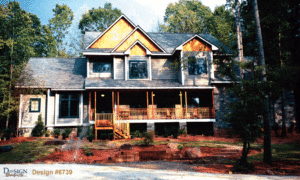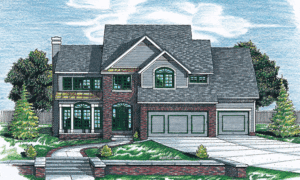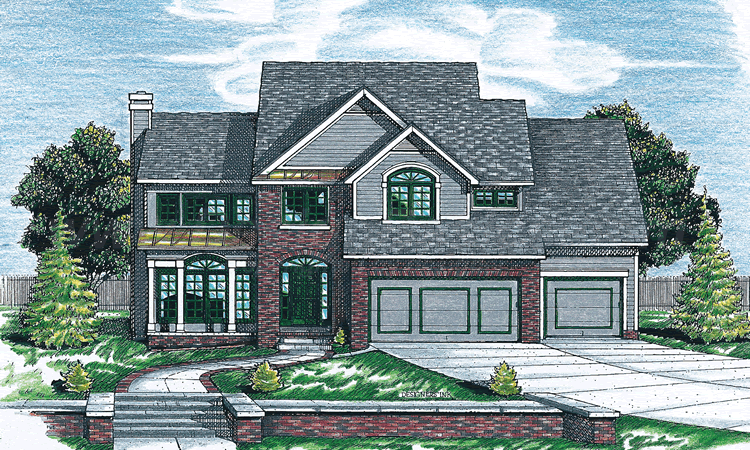While the housing recovery has not been equally distributed across North America, one thing we at Design Basics have seen in 2016 is a surge of interest in alternative construction methods (Modular, Panelized, SIP, and ICF home building). Compared with traditional onsite, “stick-framed” home building, each of the alternative methodologies offers advantages and disadvantages. One common misperception is that building systems approaches place severe constraints on home design – not true!
Modular Construction
 While some of the cheapest modular homes may look like double-wides, do not confuse mobile homes with modular construction. Yes, mobile homes and modular homes are delivered in sections via specially-designed trucks, but that’s where the similarity ends. Unlike mobile homes, modular homes are built to the same building codes as site-built homes and sit atop traditional foundations. Inspired design of multiple “modules” of different sizes can result in homes that blend in beautifully with neighboring houses.
While some of the cheapest modular homes may look like double-wides, do not confuse mobile homes with modular construction. Yes, mobile homes and modular homes are delivered in sections via specially-designed trucks, but that’s where the similarity ends. Unlike mobile homes, modular homes are built to the same building codes as site-built homes and sit atop traditional foundations. Inspired design of multiple “modules” of different sizes can result in homes that blend in beautifully with neighboring houses.
Design Basics has designed beautiful modular homes of all sizes including Jan’s House of Hope, which sailed down the eastern seaboard on a barge raising awareness – and money – in the fight against cancer. (Plan #6739 – Jan’s House of Hope; read the story)
Advantages of Modular Construction
The home can be weathertight on its foundation in as little as two days; there is almost no jobsite waste and it may be fair to say modular homes are “overbuilt,” in that they are constructed to withstand the rigors of transportation; and, there are rarely any cost overruns, but actually may be overall cost savings (dependent on local labor rates and availability).
Disadvantages of Modular Construction
Most home designs are simply not “modular friendly” and/or would be cost-prohibitive to build modularly.
Panelized Home Building
Open-wall panelized home building also takes place in factory-controlled environments where wall (and sometimes floor and roof) sections (AKA “panels”) are assembled, trucked to the jobsite, and hoisted into place with a crane. Just as engineered roof trusses have largely replaced “stick-framing” of roofs, panelized home building replaces the labor-intensive onsite stick-framing utilized in traditional home building. Open wall panels are “open” on the inside, meaning insulation will be installed later.
Advantages of Panelized Home Building
Just about any home design offered by Design Basics can be built panelized; the home can be weathertight on its foundation in just a few days; factory automation and controlled conditions help ensure consistent high quality and eliminates onsite framing mistakes; and, there may be overall cost savings (dependent on local labor rates and availability).
Disadvantages of Panelized Home Building
Once the design has been finalized and goes into production, changes can be difficult and expensive; and, it is very difficult to overcome foundation errors.
Structurally Insulated Panel (SIP)
 In contrast to open-wall panelized construction, SIP home building exterior wall and roof panels are fully built and insulated in the production facility. Although products differ among SIP manufacturers, imagine two “skins” of OSB sandwiching a thick slab of insulating foam. Electrical and plumbing runs are also typically done in the factory. (Plan #5458 SUL – Cresswell)
In contrast to open-wall panelized construction, SIP home building exterior wall and roof panels are fully built and insulated in the production facility. Although products differ among SIP manufacturers, imagine two “skins” of OSB sandwiching a thick slab of insulating foam. Electrical and plumbing runs are also typically done in the factory. (Plan #5458 SUL – Cresswell)
Advantages of SIP
Superior structural strength, energy efficiency, and environmental responsibility are SIP hallmarks, as are straighter walls, shorter onsite construction timeframes, and quiet indoor environments. With SIP roof panels, cathedral ceilings expand design options.
Disadvantages of SIP
Same as open wall panelized construction. Additionally, SIPs may be more expensive overall than traditional construction, yet your total monthly housing cost (principle + interest + taxes + insurance + utilities) will often be less.
Insulated Concrete Forms (ICF)
You may have wondered about those hollow foam blocks known as ICFs that stack like Legos to create exterior walls. Once stacked, the ICFs are filled with steel-reinforced concrete, creating high-performance homes better able to withstand severe weather. (Plan #30001 FOX – Deville)
Advantages of ICF
Extremely strong (ICF Homes have been shown to survive tornadoes) and very energy efficient. More comfortable (more even, consistent temperatures throughout the home and superb sound proofing) as well as environmentally friendly.
Disadvantages of ICF
Due to the very thick (9” – 13”) walls, homes built with ICFs are larger than their traditionally-framed counterparts (in the example ICF plan shown, the ICF version is about 200 sq. ft. larger than the standard Deville). ICF construction is usually more expensive than traditional home building, but those costs are often more than offset through lower utility bills and insurance premiums.
Design Basics has long been a leader in designing home plans for these advanced building systems. We can adapt most of the plans we offer or develop entirely new home plans for modular, panelized, SIP, or ICF construction. We design log homes, too! (Plan #7168 – Monroe)
Find your next home with our Plan Search feature.
